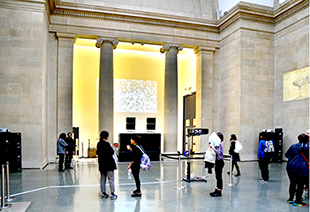![]() Coming at sound from very different directions, two UK art galleries recently put audio at the forefront of an installation – each making use of contrasting interpretations of sound zoning.
Coming at sound from very different directions, two UK art galleries recently put audio at the forefront of an installation – each making use of contrasting interpretations of sound zoning.
While Marcus Coates’ Dawn Chorus framed human beings in the context of birds singing in their natural habitat, Audint’s Delusions of the Living Dead demarked areas of the Tate Britain using what they term ‘unsound’.
The common ground between the two isn’t instantly evident, but bringing some collateral sound uses and considerations into play reveals some intriguing aspects of sound and psychology.
The first disconnect between the two installations is in the sounds used – Audint’s ‘unsound’ is a broad reference to sound that lies outside the limits of human hearing. Coates’ birdsong, meanwhile, is actually the pitch-shifted sound of people imitating the songs of birds that made up his recent installation at Brighton’s Fabrica gallery.
Coates had called on the expertise of specialist wildlife location recordist Geoff Sample to make recordings of birdsong in its natural setting, later slowing it down and having singers imitate it – it was these recordings sped back up to the pitch of the original recording that accompanied Dawn Chorus.
But it was David Reby, with his expertise in animal behaviour, animal recognition and the evolution of communication, who joined Coates for a Q&A session on Dawn Chorus and gave a further insight into the purpose of birds’ song.
Reby described another landscape than the one we recognise, one that is defined and demarked by areas of sound. The birds’ singing announced ownership of territory, claimed social dominance and advertised for a mate, among other functions. Birds navigate through these socially critical zones using these cues, while we remain largely unaware of their existence.
Audint – Toby Heys (from the Manchester Institute for Research & Innovation in Art & Design at the Manchester School of Art) and Steve Goodman (aka Kode9 from electronic label Hyperdub) – meanwhile, took their unsound to London’s Tate Britain. Running alongside a performance of their Martial Hauntology album recording, the duo had collaborated with specialist loudspeaker manufacturer Traction Sound to ‘map’ areas of the gallery using ultrasound and infrasound.

‘Ultrasound and infrasound are both outside of what is called the human hearing range but we still feel these frequencies and are affected by them,’ Heys explains of Audint’s thinking. ‘Yet we have little language and discourse to really unpack and unfold what happens when we are in the presence of such waveforms.’
Audint state that they ‘utilise infrasound and ultrasound in an attempt to explore the sensorium, its limitations and also its potential to be extended and better understood’; and the lengthy polemic that they have published pulls no punches in presenting their thinking as a serious academic endeavour as well as having its place in their art.
Imagine living in a world where the landscape is defined by sound...
Audint’s and Coates’ lines of exploration come together in our – often unconscious –awareness of sounds in nature. Weather frequencies, for example, transmit earth events way beyond the reach of our ears, yet we can be aware of them through our bodies. And at the other end of the scale, ultrasound can be detected through the bones of the face. Rupert Neve has built one of the cornerstones of his reputation on this.
While both art endeavours were presented as ‘entertainment’, they offer much more to anyone whose senses are sharp enough to pick them up.
In common pro audio parlance, zoning is almost exclusively limited to hotel PA/BGM systems and their like – this is consistent with the thinking behind both art installations, but there is more. The use of easy listening and classical music at Canadian outlets of 7-Eleven stores during the mid-1980s and later at London’s Seven Sisters tube station as a deterrent to youths loitering outside proves that the ‘weaponisation’ of sound also has zoning applications. In fact, the first use of classical music as a ‘deterrent against antisocial behaviour’ dates to Tyne and Wear Metro in 1997.
Another aspect of the destructive potential of sound worked against Audint’s Tate Modern experiment, however. The Hypersonic Sound System speakers (directional ultrasonic speakers first made for the US military) intended for linear zoning caused the organiser of the event so much anxiety that they were withdrawn from the installation. This did not stop the fearsome power of Traction Sound’s bass set-up however, its massive vibrations feeling as though they could have had structural consequences in the gallery. Audint’s ‘unsound’ experiments look set to continue, nevertheless, while Traction Sound is exploring other extended uses of its low-frequency loudspeaker technology.
We like to believe that sound is better understood by the average audio professional than by ordinary human beings in the wild, but our understanding is less than we think. And we should offer thanks to these enquiring minds for signposting new landscapes.
More: www.katemacgarry.com/artists/marcus-coates
More: http://fabrica.org.uk
More: http://audint.net
Last/Next Blog






